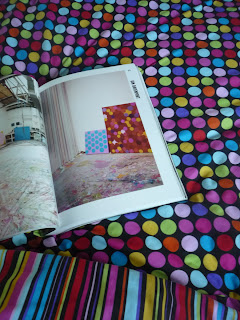Today, TOoT celebrates the recent arrival at headquarters of the most handsome volume (‘1’ indeed) of David Batchelor’s ‘Found Monochromes’, comprising a collection of 250 photographs of examples of such from the artist’s on-going (since 1997) documentary project of these finds, of blank white signs & faded notices, or the reverse planes of, encountered in, primarily, London but also other cities in Britain & around the globe, & one in Church Stretton, the streets of which A & I pottered during a recent restorative stay nearby, also taking in other delights of Shropshire.

As one might appreciate from the sample image pages below, the book constitutes a fascinating record of these occurrences of ephemeral presences/’voids’ in the visual field, ranging in scale from small sheets of paper to billboard-sized, in the fabric of the urban environment which surrounds them in many of its aspects – its architecture & the patina acquired (including graffiti); the details, the doors & windows of these buildings & establishments; its fences, barriers & divisions; its temporary construction sites; its forgotten, forlorn corners; its proliferation of signage & printed notices &, again, more impromptu instances of visual language such as graffiti.
One of course refers to the tradition of the white monochrome in modernist painting & particularly, those of Robert Ryman, & his attention also to fastenings, in the pursuit of the object & spatial environmental nature of his work, visible as a feature of a number of the monochromes photographed by Batchelor, fixed variously by selloptape, parcel tape, string, tacks, blu-tack & other means, all adding to the interest of any given image.
In each example, the white monochromes create a pause in the midst of the environment in which they are found, a still, mute point (or, otherwise, no more than a faint whisper where evidence of faded former content might be discerned through scrutiny) in the visual ‘noise’ around them, a blank canvas to be enjoyed for its purity or, perhaps if one might be so inclined, to be subjectively projected upon or a narrative ascribed to.




From such apparently simple means can a body of work of richly rewarding complexity be accumulated & constructed.
The subject of found monochromes is, of course, one that was until recently, in the form of the ‘double black lines’ markings upon the tarmac roads of a particular North Wales town, documented originally for themselves & latterly with the addition of ‘roadkill’ cans, an active aspect of the content here at TOoT & remains dear to the heart, being by no means abandoned or consigned to history – indeed, as a recent find of another occurrence of such a phenomenon amongst the streets of Chester illustrated.
Interesting to note that mention of Batchelor’s project originally came to my intrigued attention, almost a couple of years ago now, courtesy of the estimable Jazz Green & her excellent online artist’s journal: how good it is to finally have extensive tangible evidence of the ‘Found Mononchromes’, collected together in handy book form, to be studied at leisure.














































